Gymnastics is a sport of physical exercise requiring strength, flexibility, balance, and agility. It is often performed on various apparatuses and is both a competitive and entertaining sport. Gymnastics are categorized into multiple disciplines, each with specific rules.
Also Read: Gymnastics | The Art of Body Flexibility
Before we continue, it’s important to clarify that you will encounter the term “apparatuses,” which refers to the equipment used in gymnastics, such as ribbons, Clubs, hoops, Balls, Bars, High Bars, and so on.
Rules and Regulations of Gymnastics
Gymnastics has specific rules and regulations that govern the various disciplines within the sport. These rules are set by international governing bodies such as the International Gymnastics Federation (FIG) for artistic and rhythmic gymnastics and the International Trampoline Gymnastics Federation (FIGT) for trampoline gymnastics. Here are the fundamental rules and regulations for different gymnastics disciplines
General Rules
-
- Age Categories: Gymnastics competitions often have age categories and divisions to ensure fair competition among athletes of similar age.
- Code of Points: Each gymnastics discipline has its own Code of Points, which outlines the specific requirements, elements, and deductions that judges use to score routines.
Artistic Gymnastics
-
- Scoring: Artistic gymnastics routines are scored based on the execution of difficulty and artistry. Judges assign scores, and the highest and lowest scores are typically dropped, with the remaining scores averaged to determine the gymnast’s score.
- Apparatus Rules: Each apparatus (e.g., floor exercise, vault, uneven bars, balance beam) has rules regarding routine composition, skill requirements, and error deductions.
- Time Limits: Routines must be completed within specific time limits for each apparatus.
Rhythmic Gymnastics
-
- Apparatus Rules: Rhythmic gymnasts use various apparatuses (hoop, ball, clubs, ribbon, and rope), and each instrument has specific rules regarding handling, manipulation, and choreography.
- Scoring: Rhythmic gymnastics routines are scored based on the execution of artistic interpretation and body difficulty. Judges evaluate the performances for precision, grace, and expression.
Trampoline Gymnastics
-
- Scoring: Trampoline gymnastics routines are scored based on the execution of skills, including the number and difficulty of somersaults, twists, and body positions. Score deductions are made for errors such as bouncing outside the designated area.
- Safety Rules: Safety is paramount, and athletes must adhere to strict safety protocols, including proper spotting and equipment checks.
Tumbling and Acrobatic Gymnastics
-
- Apparatus Rules: Tumbling and acrobatic gymnastics involve specific skills and requirements for tumbling passes and partner/group acrobatics. Judges evaluate the execution and difficulty of these skills.
Aerobic Gymnastics
-
- Scoring: Aerobic gymnastics routines are scored based on the execution of aerobic moves, dynamic elements, choreography, and artistic expression. Judges evaluate the difficulty and synchronization of activities.
It’s important to note that rules and regulations may evolve, so athletes and coaches must stay updated with the latest rule changes and guidelines provided by their respective national and international governing bodies. These rules are in place to ensure fair and safe competition and maintain the sport’s integrity.





